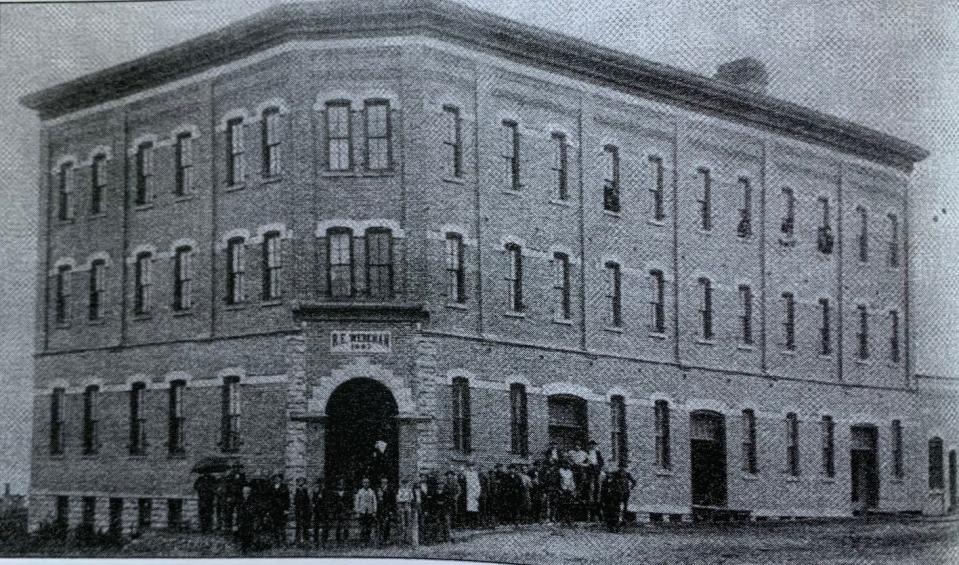Steve VanderVeen: 'The Dealmaker' of Holland, Part II
This is a continuation of last week’s story: The Deal Maker.
In 1886, Werkman was making plans for his biggest venture yet: a large factory to produce Vindicator Fanning Mills.
When Werkman received an order for 2,000 mills from a man in Allegan, he used the money to purchase 100 feet of property on Black Lake at River Avenue and Fourth Street from Ed Harrington, where he planned to build his factory.
More History: 'The Dealmaker' of Holland
More History: Harrington family made Holland history
More History: Enterprising neighbors Steketee, Scholten and Boone

But he needed more cash: $15,000, plus another $16,000 for machinery. So in 1887, Werkman requested a bonus of 10 percent of the cost of the building from the newly-formed Holland Business Men's Association. He got $1,000. He also got the Holland City Council to approve a railroad sidling, giving him both rail and water access.
To get the wood for the building and the product he hoped to produce in it, Werkman bought a mill and 400 acres of woodland in Kalkaska, a tugboat and a barge. Then he built a dock and sawmill on the land just west of his new factory, naming the venture the Werkman Lumber Company. His partners were Heber and Walter Walsh, Jan De Vries and Gerrit Boone.
Werkman also purchased a millinery at 50 E. Eighth St. in Holland, where Frances Jaye is located today, from E.F. Metz. He renamed it Werkman Millinery Emporium, then gave the business to his sisters, Hattie and Jennie, who trimmed and sold first-class hats and bonnets under the name Werkman Sisters.
In October of 1887, the new factory at River Avenue and Fourth Street, called Werkman Agricultural Works, was completed. Still short of cash, Werkman sold the Phoenix Planing Mill for $13,000 to Benjamin Scott of Bad Axe, Michigan.
In December 1887, Werkman went to Abel H. Brink of Graafschap for a loan, and Brink agreed to lend him $11,000 for two years at 10 percent interest.
In February 1888, Werkman sold his Phoenix Cheap Cash store to his cousin, H.D. Werkman.
However, Werkman's financial empire unraveled when another loan he was expecting didn't materialize. Here is another fictional account of what might have happened from Donald Van Reken and Fritz Kliphuis' "Reinder Edward Werkman: The Gilded Hollander."
"When I thought about building my new factory, I purchased the land and received an abstract of the title. I had my abstract examined by two of the most prominent attorneys in the city at the time and they gave me to understand that the title to the property was clear.

"I had the plans drawn up for the building of the factory, took them to Grand Rapids and made arrangements with the Grand Rapids Insurance Company for a loan of $10,000 as soon as I had the factory completed...
"Having completed the factory and gotten it running I needed the money to pay up my indebtedness to keep my credit....Mr. Kleinhans, the attorney for the insurance company, looked it over and then came to me with the information that I had no clear title to the property. With those words he virtually said that my entire fortune, which I had been building up, was lost."
Subscribe: Receive 6 months of unlimited digital access for $1!
Yet, in the midst of his financial troubles, Werkman married Mary Clock of Otsego. After only a few months of marriage, Mary become ill and died.
In 1889, Werkman also lost his new factory. The new owner was Abel Brink, who sold to J. Metz, Gradus Van Ark, “Black Jake” Van Putten and his brother-in-law (Cornelius VerSchure), James Huntley and Bert Slag. They renamed the business Ottawa Furniture Company.
In 1890, Werkman left for Benton Harbor, where he received a $15,000 bonus to build a factory. He sent $5,000 to Abel Brink.
But in 1893, when he returned from the World's Fair in Chicago, Werkman lost everything again. Then he left for The Netherlands. On his return, he moved to Washington State and sold real estate on Whidbey Island to Hollanders.
In 1896, Werkman married Martha Fredika Rankins of Coopersville and got a job with the Great Northern Railway. In 1898, they moved to St. Paul, Minnesota, where he continued to work for the railway as an immigration agent.
In 1901, his daughter Reona was born. In 1910, his wife, "Fanny," died while they were visiting family in Grand Rapids.
In 1916, Werkman and his daughter moved to Crookston, Minnesota. Reinder Werkman died there in 1931.
Information for this story comes from Donald Van Reken and Fritz Kliphuis' "Reinder Edward Werkman: The Gilded Hollander."
— Community Columnist Steve VanderVeen is a business professor at Hope College. Contact him at vanderveen@hope.edu.
This article originally appeared on The Holland Sentinel: Steve VanderVeen: 'The Dealmaker' of Holland, Part II

